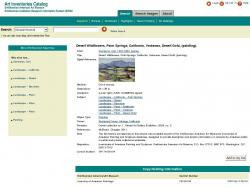Kate Harris
Social Studies teacher
Pittsburgh CAPA
Middle School (13 to 15 years old), High School (16 to 18 years old)
Teacher/Educator
Language Arts And English, Civics, Literature, Cultures, Economics, Social Studies, Geography, Writing, US History, Arts, Other
I'm a history-lover, art fan, and bookworm. I taught high school history (U.S. History and World Religions) for ten years in North Carolina, teach currently in Pittsburgh, PA, and am working to help teachers make the most of this new resource!
Kate Harris's collections
Thanksgiving--A Reflection of a Nation
A learning resource for students about Thanksgiving. The images in this collection are different portrayals of the United States holiday of Thanksgiving. They are grouped in order of publication from 1863 to 1994. As you look through them and complete the activities, think about these three key questions:<br />
-How does the context in which the image is produced affect the result? Meaning, how does what is happening during the time period affect what kind of picture of Thanksgiving we see?<br />
-What do the images say about our national identity: who is a welcome part of the United States? What do we celebrate in this country?<br />
-Whose version of the Thanksgiving story is being told in these images?
 Kate Harris
Kate Harris
15
Ancient Egypt: Canopic Jars
This is a collection of canopic jars, which were used to store the organs of the deceased in the burial chambers of ancient Egyptians. As you look through these images, think about what kinds of characteristics they all have in common. What differences do you see? Pay attention to materials used, shape of the jars, and images on the lids.
 Kate Harris
Kate Harris
7
Origin Stories from Around the World
<p> Creation myths, or origin stories, tell us what a culture believes about how humans came to be. They can also tell us much about what that culture values. These are often religious or spiritual explanations for human life. </p><p>Choose one of origin stories on this page to focus on. Read, watch, or listen to the story. Then, create a visual that illustrates a scene in the story that you think is revealing about that culture's values. Finally, write a paragraph summarizing what you learned about that culture based on their origin story.</p><p>To recap:</p><p>1. Read/watch listen.</p><p>2. Create a visual of 1 scene in the story. </p><p>3. Write a paragraph summarizing what you learned about that culture based on their origin story. <br /></p>
 Kate Harris
Kate Harris
8
Native American Policy Overview
<p>During the late 19th century, reformers in the United States like Helen Hunt Jackson pushed for a change in attitude towards Native Americans. Rather than simply viewing them as enemies from whom land could be gained, these reformers promoted the concept of assimilation, or helping Native Americans adopt the characteristics of white culture that would allow them to be successful in American society. One of the ways they did this was through the use of Christian boarding schools for Native American children. Federal laws, like the Dawes Act of 1887, also supported this goal. </p>
<p>As you investigate the artifacts, images, and readings in this collection, consider whether you think assimilation was a beneficial policy for Native Americans. How did Native American families respond to assimilation?</p>
<p>Tags: point of view, assimilation, assimilate, American Indians, Carlisle, Jim Thorpe, allotment</p>
 Kate Harris
Kate Harris
14
Ancient Egypt: A Variety of Artifacts
A topical collection to be used for student research projects.
 Kate Harris
Kate Harris
55
Droughts and Dust Bowls
This is a collection of teaching resources about droughts and the Dust Bowl. While it is mainly focused on 20th century American history, there are also some links to articles that cover droughts more broadly across time and cultures. I have included some artists (Woody Guthrie, John Steinbeck, nda Dorothea Lange) who recorded the effects of the Dust Bowl on American society. There is also a selection of lesson plans and videos that explain how farming practices and environmental changes lead to droughts, and how people have responded by changing practices and developing new technologies. <br />
<br />
Resources in this collection might be used in Language Arts, Social Studies, or Science classrooms. Questions to consider might include:<br />
-How do people impact their environment?<br />
-How do changes to the environment impact peoples' lives?<br />
-How did government and society respond to the disaster of the Dust Bowl? <br />
-What is government's responsibility in times of natural disaster?<br />
-What steps can be taken to prevent future environmental disasters?<br />
<br />
 Kate Harris
Kate Harris
27
Investigating a Place: The Pacific Northwest
<p>What defines a place? Is it its people? Economic life? Physical characteristics?</p><p>Examine this collection of images from or about the Pacific Northwest (loosely defined as Washington and Oregon states and British Columbia) to answer these questions: What are its unique set of physical and cultural conditions? How do these physical and cultural conditions interact? How does the economy of the PNW connect to its culture and geography? What are the consequences of human activity on the cultural and physical landscape? </p><p>Ask students individually or in small groups to create a collection in Learning Lab to represent the physical and cultural characteristics of another place (city, region, state). Using these collections, ask students to write summary statements describing the unique human and physical characteristics of places researched. Discuss student collections and what makes each place unique.</p><p>Tags: Portland, Seattle, Oregon, Washington, Vancouver, Native Americans, American Indians, grunge, space needle</p>
 Kate Harris
Kate Harris
38
How did the growth of railroads impact the economy, politics, and society in the period after the Civil War?
This assignment will help you respond to the question: How did the growth of railroads impact the economy, politics, and society in the period after the Civil War? As you work through the activity, you will want to complete the organizational chart with your analysis of each artifact or resource. When you are finished, write your essay response using information from your chart. You will submit the file to your teacher in the format they have requested.
 Kate Harris
Kate Harris
14
Great Ideas, Modern Art, and Advertising
This collection consists of advertisements created for the Container Corporation of America in the 1950s. Each advertisement pairs a quote from a "Great Idea of Western Man" with a work of original art. After reviewing the collection, students will create their own art work to reflect a "Great Idea" that they think is important and meaningful in the world today.
 Kate Harris
Kate Harris
11
The Emancipation Proclamation
<p>How did the writing of the Emancipation Proclamation reflect the political tensions of the time? This collection reviews the writing, impact, and legacy of the Emancipation Proclamation through videos, informational texts, and art. Students can work through the lesson independently and their understanding of the Emancipation Proclamation will be assessed via quiz questions. Students will be able to determine the short-term and long-term impacts of the Emancipation Proclamation.</p>
 Kate Harris
Kate Harris
17
Leonidas at Thermopylae
<p>This 2-resource collection is intended to introduce students to the Battle of Thermopylae through an artistic interpretation and a map and graph rendering. It could be used as a short bellringer, warm-up, or homework activity prior to in-class discussion of the battle.</p><p>Tags: Sparta, Greece, Greek, Persia, Xerxes</p>
 Kate Harris
Kate Harris
4








